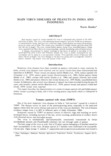Main Virus Diseases of Peanuts in India and Indonesia
Tropical agriculture research series : proceedings of a symposium on tropical agriculture researches
| ISSN | 03889386 |
|---|---|
| NII recode ID (NCID) | AA00870529 |

Full text
tars19-_129-133.pdf1.01 MB
Bud necrosis caused by tomato spotted wilt virus is widespread and common in the semiarid areas of India. The virus with membrane-bound isometric particles 70-90 nm in diameter, is transmitted by thrips, and has a very wide host range. Clump disease was observed on peanut grown in sandy soil in India. The causal virus consisted of straight tubular particles about 250 and 185 nm in length. The virus, named Indian peanut clump virus, resembled peanut clump virus reported from West Africa in symptomatology, particle morphology and soil-borne nature.
A disease characterized by mosaic mottling on the leaves of peanut is prevalent in the peanut-growing areas of Java and Sumatera islands. The virus is readily transmitted by sapinoculation and by aphid in a non persistent manner. Virus particles consist of flexuous rods about 750 nm in length. The virus belongs to the potyvirus group and is serologically related to peanut chlorotic ring mottle virus and peanut stripe virus.
A disease characterized by mosaic mottling on the leaves of peanut is prevalent in the peanut-growing areas of Java and Sumatera islands. The virus is readily transmitted by sapinoculation and by aphid in a non persistent manner. Virus particles consist of flexuous rods about 750 nm in length. The virus belongs to the potyvirus group and is serologically related to peanut chlorotic ring mottle virus and peanut stripe virus.
| Date of issued | |
|---|---|
| Creator | Norio Iizuka |
| Publisher | Japan International Research Center for Agricultural Sciences |
| Volume | 19 |
| spage | 129 |
| epage | 133 |
| Language | eng |
